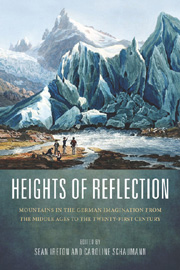 Heights of Reflection
Heights of Reflection Book contents
- Frontmatter
- Contents
- Acknowledgments
- Introduction: The Meaning of Mountains: Geology, History, Culture
- Prelude: Classical Mountain Landscapes and the Language of Ascent
- Part I First Forays: Mountain Exploration and Celebration from the Middle Ages to the Eighteenth Century
- Part II Beckoning Heights: Summits Near and Far in the Nineteenth Century
- Part III Modern Expeditions and Evocations: Climbing from the Twentieth into the Twenty-First Century
- Leaving the Summit Behind: Tracking Biographical and Philosophical Pathways in Richard Strauss's Eine Alpensinfonie
- Elevation and Insight: Thomas Mann's Der Zauberberg
- “The Essence of the Alpine World Is Struggle”: Strategies of Gesundung in Arnold Fanck's Early Mountain Films
- “Mountain of Destiny”: The Filmic Legacy of Nanga Parbat
- Spatial Orientation and Embodied Transcendence in Werner Herzog's Mountain Climbing Films
- W. G. Sebald's Magic Mountains
- Conflicting Ascents: Inscriptions, Cartographies, and Disappearance in Christoph Ransmayr's Der fliegende Berg
- Works Cited
- Notes on the Contributors
- Index
Elevation and Insight: Thomas Mann's Der Zauberberg
from Part III - Modern Expeditions and Evocations: Climbing from the Twentieth into the Twenty-First Century
Published online by Cambridge University Press: 05 February 2013
- Frontmatter
- Contents
- Acknowledgments
- Introduction: The Meaning of Mountains: Geology, History, Culture
- Prelude: Classical Mountain Landscapes and the Language of Ascent
- Part I First Forays: Mountain Exploration and Celebration from the Middle Ages to the Eighteenth Century
- Part II Beckoning Heights: Summits Near and Far in the Nineteenth Century
- Part III Modern Expeditions and Evocations: Climbing from the Twentieth into the Twenty-First Century
- Leaving the Summit Behind: Tracking Biographical and Philosophical Pathways in Richard Strauss's Eine Alpensinfonie
- Elevation and Insight: Thomas Mann's Der Zauberberg
- “The Essence of the Alpine World Is Struggle”: Strategies of Gesundung in Arnold Fanck's Early Mountain Films
- “Mountain of Destiny”: The Filmic Legacy of Nanga Parbat
- Spatial Orientation and Embodied Transcendence in Werner Herzog's Mountain Climbing Films
- W. G. Sebald's Magic Mountains
- Conflicting Ascents: Inscriptions, Cartographies, and Disappearance in Christoph Ransmayr's Der fliegende Berg
- Works Cited
- Notes on the Contributors
- Index
Summary
Nineteen twenty-four, the year Thomas Mann's Der Zauberberg (The magic mountain) was published, is an important date in the history of the representation of mountains. In the German tradition, this novel is the most prominent work of literature whose entire plot and structure draw on mountains. It offers an investigation into the repertoire of established tropes of mountain discourses from Petrarchan humanism and the Romantic sublime to the thrill of sport and mountain climbing in modern times. Absorbing literary traditions as well as contemporary travel literature and commonplaces of an emerging bourgeois mountaineering culture, Mann's novel has also shaped the future of mountain literature to the degree that it established itself as a canonical work of German literature. Its publication therefore constitutes a turning point in the way in which the Alpine realm is experienced and represented. After 1924, the mountains would never be the same again.
Few facets of the novel — from the details of contemporary Davos to the allegoric and sociopolitical — have eluded scholarly attention, and since the 1990s the medical dimension of the novel has become a major field of inquiry. But only a handful of interpreters have granted this dimension the importance it deserves. Far from being a subsidiary aspect, it constitutes a major thematic and formal innovation in the text. Although Hans Castorp, the novel's protagonist, experiences the mountains as a place of beauty (or alternatively of the sublime), of humanist reflection, and of sport, these experiences — and with them the reader's expectations — are undermined by irony.
- Type
- Chapter
- Information
- Heights of ReflectionMountains in the German Imagination from the Middle Ages to the Twenty-First Century, pp. 248 - 266Publisher: Boydell & BrewerPrint publication year: 2012


